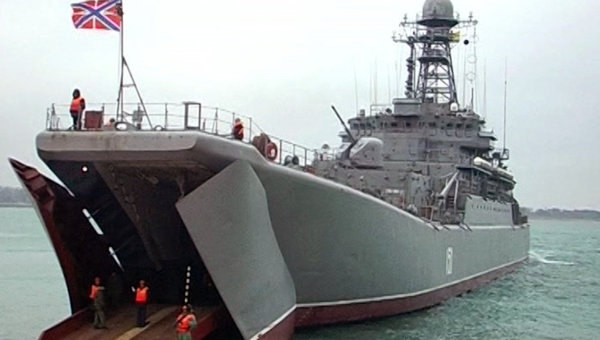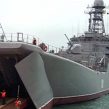
What Is the Significance of Russia’s Black Sea Maneuvers?
Publication: Eurasia Daily Monitor Volume: 10 Issue: 65
By:

At 4 a.m. on March 28, President Vladimir Putin delivered a sealed letter to Defense Minister Sergei Shoigu ordering him to launch at once unscheduled maneuvers involving not just the Black Sea Fleet but air and airborne forces and the Army. The exercises wound down within days, and the troops were back in their bases by March 31 (Interfax, March 28, 30). To understand the significance of these maneuvers, one must see them in context.
First, these exercises were clearly an attempt to compensate for the widespread failings uncovered in the February 17–21 snap maneuvers involving large sections of the Russian military that indicated a pervasive lack of readiness. They were not the only such maneuvers conducted at this time, only the most prominent ones. In conjunction with these latest surprise military exercises, the Strategic Missile Command conducted an impromptu check of missile troops in Tver Oblast, and Russia also carried out exercises for Long-Range Aviation forces in the Saratov region (Ministry of Defense of the Russian Federation, March 30; Interfax, March 29). Simultaneously, Russia’s fleet in the South China Sea also conducted a live-fire exercise (Interfax-AVN, March 28).
Second, a major goal of the military reforms since 2008 was the reshaping of the military to be able to conduct joint operations led by a single command-and-control center. In this case, the Black Sea Fleet carried out that role, and this exercise, like so many that preceded it, was very much about finding out whether or not the Fleet or other command-and-control centers in previous exercises could do so effectively. Thus, the late March 2013 exercises involved 36 ships of the Black Sea Fleet, ground troops, military aviation, rapid reaction forces, airborne and naval infantry troops, as well as Spetsnaz subunits from the GRU comprising the largest exercise of that post-Soviet fleet’s history (Zvezda TV, March 28; Rossiya 24 TV, March 28). Apart from combat forces, the surprise exercise also involved military intelligence, transport, logistics and engineer support units—so it appears to have been a rehearsal of a large-scale, comprehensive combined forces operation. In all, over 7,000 troops, up to 250 armored vehicles, over 50 different artillery pieces, 20 combat ships and helicopters, as well as 36 ships from the fleet took part in these maneuvers (Rossiya 24 TV, March 28).
Third, the exercise also consisted of a coastal landing operation in the Caucasus where the fleet, helicopters, and fighter and reconnaissance aircraft supported the marines landing ashore (Interfax-AVN Online, March 29). While one may plausibly say that the scope and size of the exercise described here was intended to demonstrate the regionally concentrated Russian forces’ capabilities to deploy at a moment’s notice and move to a combat theater, there are more disturbing aspects of this exercise. Indeed, the ground forces undertook a 500-kilometer forced march, while the airborne forces came from the Moscow, Ryazan and Tula divisions (Rossiya 1 TV, March 29). Although Russian leaders claimed that, under international agreements, they did not need to provide notice of the impending maneuvers to Russia’s neighbors because they kept the exercise under 9,000 men, it is clear that the implications of this exercise are disturbing for both Georgia and Ukraine (Interfax, March 28). This is not just a question of Russia following up on its negative reaction to joint US-Georgian exercises earlier in March and attempting to demonstrate that it remains the sole dominant power in the Caucasus and Black Sea region. As Aleksandr’ Golts suggested, the recent March exercises demonstrate that Moscow can, at a moment’s notice, call up its forces and attack Ukraine or Georgia without warning—with no regard for the fact that the Black Sea Fleet is stationed on what is Ukrainian territory and that at least parts of Russia’s regional ground and air forces are located on Georgian territory (Moscow Times, April 3). This suggests Moscow’s real view of these countries’ territorial integrity and sovereignty. Moreover, Golts ridiculed official proclamations that the exercises complied with international agreements, showing that Moscow violated the spirit, if not the letter of those accords (Moscow Times, April 3). Moscow may claim that it and Kyiv are ready to agree on the movement of the Black Sea Fleet’s units, but this fait accompli underlines what the real situation is like there (Interfax, March 28).
Therefore, it is hardly surprising that Georgia’s foreign ministry issued a statement expressing its “grave concern” about this provocative action (Ministry of Foreign Affairs of Georgia, March 28). While the North Atlantic Treaty Organization (NATO) offered no official response, there certainly was some disquiet in Brussels at Moscow’s actions (probably what Moscow actually intended) (Eurasia Insight, March 29).
Interestingly, there was also no sign of an official Ukrainian response indicating unease, simply registering the event, or anything else. Indeed, Moscow had reportedly officially notified Ukraine six days earlier in accordance with bilateral agreements about the impending exercises (www.ukrainebusiness.com, March 29). Nonetheless, it appears that such snap maneuvers may become the norm to ensure the readiness of the Russian armed forces and the success of the military reforms. And Moscow will likely continue to demand that the Black Sea be seen as a closed Russian sea—a “Mare Clausum et Nostrum.” One can only speculate how this exercise will affect the future of the forthcoming permanent Mediterranean “naval operational division” that Moscow is planning, which will almost certainly grow out of the Black Sea Fleet (see EDM, March 7). In this part of the world, ever more interesting times are almost certainly in the offing.




